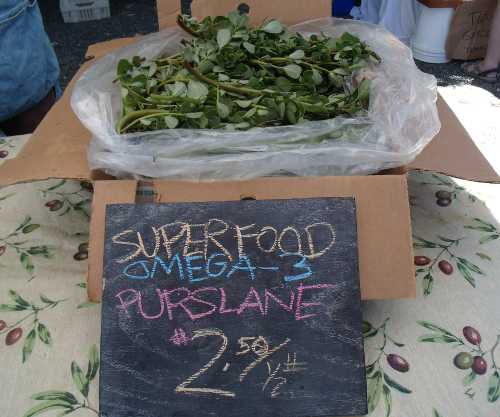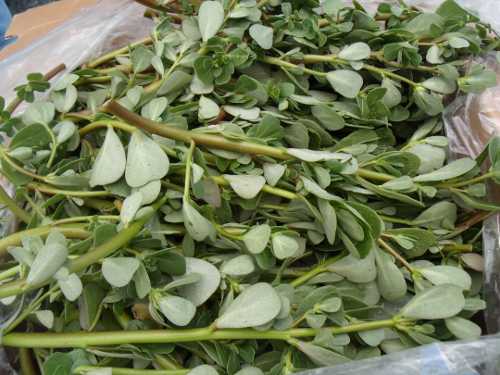
I’d say it’s a miracle crop; however, many call it a weed. Today’s highlighted veggie, purslane, is a victim of such unfortunate mistaken identity.
Purslane, a succulent, is native to India and Persia (modern-day Iraq), though some opine that South Africa is its original home. It enjoys favor as an edible plant throughout much of the world, including Europe, the Middle East, Asia and Mexico.
While it’s primarily considered a weed in the United States, this attitude is slowly changing, particularly because of its health benefits. Many have turned their attention to this garden creeper come desirable food source, from the U. S. Department of Agriculture to upscale restaurant chefs.
I first made purslane’s acquaintance two weeks ago at a local farmers’ market. It was piled high at the stall of Full Moon Farm of Kelseyville and, curious, I stopped to take a look.
Farmer Sean Mooney filled me in on its benefits and offered me a taste. I was immediately taken by its fresh, lemony flavor, reminiscent of the sidewalk sour grass my friends and I ate as kids, albeit far milder.
The bunch I took home was lovely in our salad at dinner that evening, along with other, milder greens, a bit of olive oil and a splash of balsamic vinegar.
Though purslane is delightful as a green in salads, sandwiches, tacos and the like, its weight and mouth feel are more substantial than lettuce. I find the extra heft and crunch satisfying.
I checked in with Mooney about its current availability, and he reported that the small window for harvesting the crop is over; however, readers may have it as a volunteer in home gardens, so I thought information on the plant would be useful.
Perhaps this article will inspire some to seek it out at local nurseries for home plantings.
Purslane trails and creeps along the ground as it grows, making it a popular landscaping plant. Its thick, reddish stems are crowded with clusters of oval leaves that look like those of the jade plant, though not as thick and spongy.
In the wild the blooms of common purslane are small and yellow; however, other varieties have larger flowers in a wide swath of other shades, including white, pink, red and magenta.
These are sometimes called the “Dolly Parton flower” because of their tendency to bloom from 9 a.m. to 5 p.m., a reference to her 1980 song and comedic movie.
Because purslane grows readily in the wild, it is often foraged. If so, one should be cautious of spurge, a somewhat similar-looking but toxic plant that is sometimes found growing near it, even intertwining. Unlike purslane, spurge has wiry, not thick, stems and gives off a white, milky sap when broken.
As already mentioned, purslane has tremendous stores of Omega-3 fatty acids, containing more than any other green plant. These are beneficial to the heart, as well as help in prevention of certain cancers.
In addition, purslane has antifungal, antimicrobial and antibiotic properties and is a rich source of vitamins A, B, C and E. It contains the minerals calcium, magnesium, potassium and folate, as well as high amounts of beta carotene.
Purslane has a long history of medicinal use, going back some 2,000 years, including by ancient cultures in China, Greece, and Rome, by African Zulus and Australian aboriginal peoples.
In Mexico, purslane is called “verdolaga” and is a favorite comfort food. There it’s added to omelets, soups and stews, cooked as a side dish and rolled into tortillas.

Purslane can be substituted for spinach or other greens in lasagnas, filled pastas and Greek-style savory tarts, such as spanakopita.
My mother’s ancient, original “Joy of Cooking” suggests purslane be used in place of sorrel in a cream soup or blanched for a side dish. Interestingly, the authors refer to it as Mahatma Gandhi’s favorite vegetable, not unlikely due to its popularity in India.
Purslane may be paired with potatoes in a creamy soup or as part of a vinaigrette-dressed potato salad. Other recipes include pairing it in a stew with pork, lamb or lentils, using it in pasta salad or adding it to gazpacho.
One of the more creative uses for purslane I’ve seen is its addition to a tzatziki-like Greek salad made with cucumbers, yogurt, and mint.
Purslane is best used when freshly picked; however, it should keep for a few days when wrapped in a moist paper towel and stored in a plastic bag in the vegetable crisper section of the fridge.
There seem to be differing opinions regarding the use of purslane’s stems. While edible, they lack the tenderness of its leaves and only the most delicate of stems should be used.
The following recipe for purslane salsa is courtesy of www.prodigalgardens.info, a Web site on medicinal herbs and wild foods. Made with tomatillos, this is a green-colored salsa.
You can also use your favorite existing salsa recipe and throw in some fresh purslane leaves for added taste. They also serve as a thickener. Either way, salsa’s bound to be delicious with herbaceous purslane!
This salsa (or the salsa of your choice with added purslane) may be added as part of the cooking liquid for rice for an interesting take on Spanish rice. When finished, some fresh purslane leaves may also be added.
Purslane salsa
4 cups fresh tomatillos
2 cups fresh purslane leaves
4 to 5 green chiles, roasted and peeled with seeds removed
3 garlic cloves, crushed
¼ fresh minced cilantro
Salt to taste (about ¼ to ½ teaspoon)
Puree tomatillos in a food processor or blender, then simmer on stove top for about 15 minutes. Chill.
Coarsely chop purslane leaves.
Mix all ingredients and add salt to taste.
Recipe courtesy of www.prodigalgardens.info.
Esther Oertel, the “Veggie Girl,” is a culinary coach and educator and is passionate about local produce. Oertel teaches culinary classes at Chic Le Chef in Hidden Valley Lake, Calif., and The Kitchen Gallery in Lakeport, Calif., and gives private cooking lessons. She welcomes your questions and comments; e-mail her at This email address is being protected from spambots. You need JavaScript enabled to view it..
Follow Lake County News on Twitter at http://twitter.com/LakeCoNews, on Tumblr at www.lakeconews.tumblr.com, on Facebook at http://www.facebook.com/pages/Lake-County-News/143156775604?ref=mf and on YouTube at http://www.youtube.com/user/LakeCoNews.

 How to resolve AdBlock issue?
How to resolve AdBlock issue? 





